Malcolm R. Campbell's Blog, page 227
May 24, 2013
Memorial Day, a Day of Memories Sweet and Sad
At first light, the memories will find us. They are infinite and deep, though time has stripped away the individuals’ names, their faces even, who fell lifetimes ago on our behalf. Those who fell, fell for the future, for generations hardly close enough to dream about, for worlds not yet born and hopes not yet conceived.
Following the journeys of the fallen, we cannot help but think of Lincoln’s Words, “we can not dedicate…we can not consecrate…we can not hallow this ground.” It has already been consecrated, and we cannot add or detract from it as we keep the sweet and sad memories close in our hearts.
Before the twilight’s last gleaming, we will have followed our fathers and grandfathers, our mothers and grandmothers, our friends and our neighbors’ friends down the long miles of Memorial Day. It is, as Lincoln said in 1863, the “unfinished work which they who fought here have thus far so nobly advanced.”
Our dedication comes at a great expense of time and money as we walk the aisles our ancestors walked according to the customs of their times. The aisles are more modern now: the pickle barrel and the checker board have long since been replaced with the folkways of a new century. But we are diligent. We soldier on from appliances to apparel, from tools to jewelry, from sports and fitness equipment to automotive sales.
When evening comes, the remains of the day will sit upon tables and counter tops in either paper or plastic comprising our developing memories, both sweet and sad, of our trek across the sacred ground, kept pure and holy for those whom we follow into the night.
-
 Copyright (c) 2011 by Malcolm R. Campbell
Copyright (c) 2011 by Malcolm R. Campbell
Excerpted from the Pushcart nominated Jock Talks…Politics


May 22, 2013
Spring Fantasy Novel Giveaway for ‘The Seeker’ – Third Excerpt
“The Seeker,” by Malcolm R. Campbell, Vanilla Heart Publishing (April 14, 2013), contemporary fantasy, 224 pages, trade paperback, Kindle, Nook, PDF
The Novel
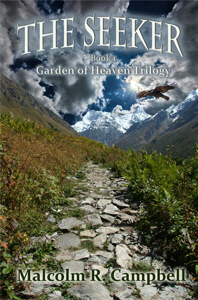 Adventure, love, loss, war, and betrayal in this Book 1 of the Garden of Heaven Trilogy, The Seeker.
Adventure, love, loss, war, and betrayal in this Book 1 of the Garden of Heaven Trilogy, The Seeker.
The story begins in the high country of Montana where young David Ward negotiates life with his dysfunctional grandparents (Katoya the medicine woman and Jayee the railroader and surveyor) and sees his future spread out before him in a vision quest. He meets his soul mate while employed as a seasonal worker at a resort hotel, saves her life on a dark street in Florida, and runs afoul of the consequences of using old magic to alter a person’s destiny.
The Giveway
One autographed trade paperback copy available within the United States and three Smashwords coupons for e-book downloads in multiple formats available anywhere.
How to Enter: All you have to do is leave a comment, hopefully friendly, on any of the five posts entitled Spring Fantasy Novel Giveaway for ‘The Seeker,” followed by an excerpt number by midnight (U.S. eastern daylight time) on May 31, 2013. Please include an e-mail address, Facebook page, web site, or other online way I can find you if you are among the winners.
On June 1, 2013, I will put the names of all the commenters from the five posts into a hat. The first name drawn out wins the paperback; the next three win a Smashwords coupon.
Good luck!
Brief Excerpt Number Three – Of Flood and War

Neighborhood west of the park…a scene repeated in multiple towns
On August 4, 22 illusory torpedoes were launched by North Vietnamese patrol boats against the U. S. destroyers Maddox and C. Turner Joy in the Gulf of Tonkin. Born a world away from the lotus falling into a sea of fire, the sweet fictions of credibility gap sustained them long enough for the prescribed protocols to ensure the hardship of 58,175 deaths, the price of 153,303 wounded, and the burden of a national psyche forever scarred.
On August 4, David called out the names of the stars as he walked with Anne Hill in the Garden of Heaven. They kissed in the spray of Morning Eagle Falls and made promises they could never keep. Born of blue columbine and larkspurs beneath the Angel Wing on top of the world, their sweet fictions sustained them long enough to ensure they would be forever scarred.
On August 12, David’s birthday, he and his longtime friend Tom Elliott hiked along Lower Two Medicine Lake, unprepared for the scars left by the June floods. For the world at large, the evidence of Montana’s worst flood—a “zone of war,” according to the Associated Press—would be short lived in spite of the towns, bridges, livestock, dams, Great Northern mainline, roads, houses, and families that were down, out, broken, undercut, missing, ruined, and swept away when time was flung in a crowned deluge down the rivers, the Bear, Big Blackfoot, Birch, Cameron, Clark Fork, Cottonwood, Dearborn, Divide, Dupuyer, Flathead, Grant, Hardy, Kennedy, Little Blackfoot, Marias, McDonald, Missouri, Moccasin, Ousel, Sheep, Spring, Sun, Swan, and Teton.
“I lost friends down there—too many to help simultaneously,” Tom said, as they climbed up Looking Glass Hill, leaning on their alpenstocks like old men.
“Grandmother won’t speak the names of the dead,” David replied. “She says they’re heavy on her tongue.”
“Sure, sure, yet the name is not the river, nor the town, nor the man.” Tom lit his pipe. “But the names are not without weight.”
“Are they heavier than smoke?” David asked.
“About the same,” he said, “but they’re prayers nonetheless.”
You can see the book’s Amazon listing here and its Barnes & Noble listing here. Excerpt number one is posted here. Excerpt number two is posted here.


May 21, 2013
Stephen King, Joyland and the Lure of Pulp
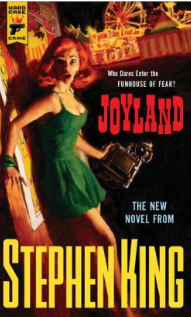 A haunted carnival funhouse gives a supernatural spin to events in Thriller Award–winner King’s period murder mystery with a heart. In the summer of 1973, 21-year-old college student Devin Jones takes a job at Joyland, a North Carolina amusement park. Almost immediately, a boardwalk fortune-teller warns that Devin has “a shadow” over him, and that his destiny is intertwined with that of terminally ill Mike Ross, a 10-year-old boy who has “the sight.” – from the Publishers Weekly review of Stephen King’s “Joyland” (June 2013 release)
A haunted carnival funhouse gives a supernatural spin to events in Thriller Award–winner King’s period murder mystery with a heart. In the summer of 1973, 21-year-old college student Devin Jones takes a job at Joyland, a North Carolina amusement park. Almost immediately, a boardwalk fortune-teller warns that Devin has “a shadow” over him, and that his destiny is intertwined with that of terminally ill Mike Ross, a 10-year-old boy who has “the sight.” – from the Publishers Weekly review of Stephen King’s “Joyland” (June 2013 release)
Anyone Stephen King’s age or older has been impacted by pulp fiction whether we’ve read any of it or not. Pulp, referring to the cheap paper, covered a lot of genres from westerns to mysteries to sports to gangsters. It was cheaply produced and, so some people say, never could have seen the light of day in the up-scale “slicks” or “glossies”—the magazines and books printed on better paper.
The cover art, which was usually suggestive, garish, colorful, and over the top, meant that readers typically wouldn’t let their parents, teachers, office workers, pastors, and spouses see the books. In terms of magazines, most pulps died out during the 1950s as the sixty-year-old publishing approach began to run its course. Today, the book covers that were once considered scandalous are now considered “camp” and/or treasures of a bygone era that began with Argosy Magazine and included authors H. Rider Haggard, Edgar Rice Burroughs and Talbot Mundy.
“Undeniable…charm [and] aching nostalgia…[JOYLAND] reads like a heartfelt memoir and might be King’s gentlest book, a canny channeling of the inner peace one can find within outer tumult.” – Booklist
The cover of Stephen King’s upcoming novel Joyland screams PULP. Published by Hard Case Crime, the look of the book is intentional as its author takes a nostalgia trip back to his roots and the fiction he grew up reading. The publisher is a friend of pulp:
Hard Case Crime brings you the best in hardboiled crime fiction, ranging from lost noir masterpieces to new novels by today’s most powerful writers, featuring stunning original cover art in the grand pulp style.
Though King embraced e-books early on, Joyland will be available in paperback only. That’s made bookstores happy and caused other people to wonder what King is up to when he says, “I have no plans for a digital version. Maybe at some point, but in the meantime, let people stir their sticks and go to an actual bookstore rather than a digital one.”
Pulp seems to be less pulpy on a Kindle or a Nook. Perhaps that, and the nostalgia of those pulpy old days is sufficient rationale for the paperback-only release. Personally, I would like to see some other major writers delay the release of the digital versions of their books. Only the prosperous could afford to do that, to go against the tide that often washes e-books up on shore before the paperback and hardcover releases.
Some years ago, literary agent Mort Janklow said of King, “That’s a fellow sitting up in Maine having fun, but it’s not a way to run a business.”
No, it probably isn’t. But I like it. I like it even on a day when I’m talking to the regional library system about including e-book editions of my novels on their e-lending lists. I like it because it’s fun. And yes, I’ll buy a copy at a bricks-and-mortar bookstore because that’s part of what pulp fiction is all about, walking in, making sure Mom, Dad or the school teacher aren’t around, and grabbing a copy of the latest hardboiled story off the spinning rack of books.
I remember the thrill of all that and I’ll enjoy going back in time to renew my memories. Unlike the old days, this book has glowing reviews from mainstream reviewers. I almost wish it didn’t.
–Malcolm


May 19, 2013
Review: ‘Suffering Succotash: The Comic Life of Molly Maise,’ by Lula Mae Barnes
Satire from the archives
Suffering Succotash: The Comic Life of Molly Maise,” by Lula Mae Barnes (Corn Fritter Press, September 2012), 4,837pp with illustrations, index, maps, and bibliography.
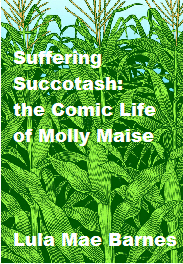 As time goes by, fewer and fewer people remain on this Earth who suffered through depression-era and Thanksgiving meals constructed substantially of succotash.
As time goes by, fewer and fewer people remain on this Earth who suffered through depression-era and Thanksgiving meals constructed substantially of succotash.
“As far back as the Revolutionary War,” writes Lula Mae Barnes in her new and overly definitive biography of the 1770s Rhode Island innkeeper, dancer and lady of the evening Molly Maise, “people were thankful to live off succotash when times were hard and just as thankful to get rid of the vile mixture when good fortune smiled upon them again.”
Barnes, who spent the last fifty years uncovering the obscure details of the inventor of succotash, claims that the mixture of corn, various forms of beans and minced oaths is far too improbable a concoction to have occurred by accident.
Young Molly Maise, an innkeeper on Aquidneck Island who supported the “divine cause of everything that wasn’t British,” devised succotash as a “devious treat” for British sailors enjoying her favors in the days leading up to the 1778 Battle of Rhode Island. Ever after, she claimed her succotash made the sailors so ill, they scuttled their own fleet to kill the pain. While historians agree that the fleet was scuttled, they do not cite succotash as a cause.
According to Barnes, Maise spent a lifetime giving humorous talks, some bawdy, about the ills of succotash and the role it had in the war. While her speeches and dance routines, including “The Succotash Rag” (which pre-dated the American Ragtime boom by one hundred years) were well attended, she failed to gain the validation as a soldier and inventor she was seeking.
In fact, the biography’s references clearly indict most, if not all, of the United States’ founding fathers, soldiers, newspapermen and historians of a “treasonous level of guilt” for their roles in covering up the role of Molly Maise and succotash in “the cause of freedom.”
Barnes’ epic work clearly shows that every human’s recipe for defeat is based on the foods they eat, how they mix them together, and what they name the resulting entree. Had Maise called her corn and beans a Corn & Bean Medley, history might have duly honored her for the suffering her invention caused herself and all the generations that followed.
The epitaph on Maise’s tombstone reads: “Loose corn and beans sink ships faster than loose lips.”



May 18, 2013
Spring Fantasy Novel Giveaway for ‘The Seeker’ – Second Excerpt
“The Seeker,” by Malcolm R. Campbell, Vanilla Heart Publishing (April 14, 2013), contemporary fantasy, 224 pages, trade paperback, Kindle, Nook, PDF
The Novel
 Adventure, love, loss, war, and betrayal in this Book 1 of the Garden of Heaven Trilogy, The Seeker.
Adventure, love, loss, war, and betrayal in this Book 1 of the Garden of Heaven Trilogy, The Seeker.
The story begins in the high country of Montana where young David Ward negotiates life with his dysfunctional grandparents (Katoya the medicine woman and Jayee the railroader and surveyor) and sees his future spread out before him in a vision quest. He meets his soul mate while employed as a seasonal worker at a resort hotel, saves her life on a dark street in Florida, and runs afoul of the consequences of using old magic to alter a person’s destiny.
The Giveway
One autographed trade paperback copy available within the United States and three Smashwords coupons for e-book downloads in multiple formats available anywhere.
How to Enter: All you have to do is leave a comment, hopefully friendly, on any of the five posts entitled Spring Fantasy Novel Giveaway for ‘The Seeker,” followed by an excerpt number by midnight (U.S. eastern daylight time) on May 31, 2013. Please include an e-mail address, Facebook page, web site, or other online way I can find you if you are among the winners.
On June 1, 2013, I will put the names of all the commenters from the five posts into a hat. The first name drawn out wins the paperback; the next three win a Smashwords coupon.
Good luck!
Brief Excerpt Number Two – Vision Quest
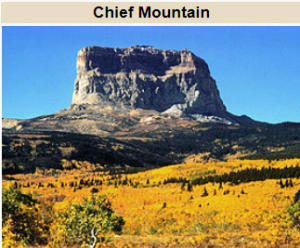
David’s vision quest occurs at the summit of Chief Mountain, a prominent peak near the border of Montana and Alberta. – Wikipedia photo
Now the mountains loomed beneath a red sun that dripped blood into the rivers. The noise was deafening like war or a heart out of control. From the smoke of trees that burnt charged a horse with a name that was Sikimí, black, dripping sweat and salt, ruler of storms, pawing the earth into ridges, tearing clouds off the sky, chasing a primitive injunction behind wild eyes. David ran, and when Sikimí was larger than life behind him, he stumbled into a loop of Stookatsis vine—ghost’s lariat—and fell against crumbled rocks left when Nápi ripped Kátoysix from their mother. Suffice it to say, time did not give him leave to contemplate the point of a small white cross that drove through the palm of his left hand like a large nail as he fell. But he saw the spark in Sikimí’s left eye before he felt the hooves.
-
You can see the book’s Amazon listing here and its Barnes & Noble listing here. Excerpt number one is posted here. There is also a giveaway for “The Seeker” on GoodReads (ending May 21, 2013).


May 17, 2013
Review: ‘Butterfly Moon,’ by Anita Endrezze
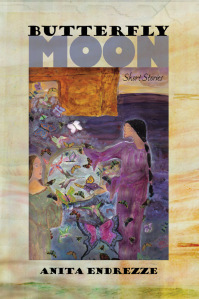 The fifteen stories in this finely honed and well-polished collection have the power to cut away assumptions and alter a reader’s focus and direction as only a storyteller’s magic can do. Borrowed and reshaped from older folktales out of Anita Endrezze’s heritage and imagination, these stories take on new life in their contemporary settings.
The fifteen stories in this finely honed and well-polished collection have the power to cut away assumptions and alter a reader’s focus and direction as only a storyteller’s magic can do. Borrowed and reshaped from older folktales out of Anita Endrezze’s heritage and imagination, these stories take on new life in their contemporary settings.
In her author’s note, Endrezze writes, “I hope Butterfly Moon will take you adrift in another world that challenges and transforms your perceptions, yet leads you back home to yourself.”
Reality, the oldest shapeshifter we know, dances lightly on the pages of Butterfly Moon and often gives way to enchantments, supernatural events, and the whims of gods and fate. As prospective blessings for the reader’s journey, these stories don’t necessarily fit the traditional narrative arc of a problem leading to a climax. Endrezze’s tales are often unresolved slice-of-life glimpses into her characters and settings that end with a dire occurrence, an acceptance of fate, a troubling paradox or the workings of karma.
The joy, anger, life, and death in Endrezze’s vision are not bound by time, nor are they distinctly separate from the active and sentient world in which they’re set. “On This Earth” begins with the words, The house was a forest remembering itself. The pine trees that held up the walls dreamed of stars dwelling in their needles. When Desetnica leaves home to roam the world in “The Dragonfly’s Daughter” because she is the tenth child, it’s clear that the forest is watching when The blackberry bushes parted their thickets as I waded through green knots of fruit. After I passed, still following the dragonfly, the vines knitted together again, so that I was lost to the other side of kinship and orphaned into the unnamed forest.
While tightly knit into the stories’ plots, myth and symbolism add depth without intruding into the author’s economy of words, understated approach and matter-of-fact reverence to the cultural origins of her material. Endrezze does not explain or editorialize, but her omniscient care is everywhere through this collection from the paradoxes of “Raven’s Moon” to the grim unfolding of “The Vampire and the Moth Woman” to the humor of “Jay (Devil-may-care!)”
For the lovers of myths, legends, and folktales, this collection is highly recommended and a unique delight.
Malcolm R. Campbell is the author of paranormal short stories and contemporary fantasy novels, including the recently released mix of love and fate called “The Seeker.”


May 16, 2013
Spring Fantasy Novel Giveaway for ‘The Seeker’ – First Excerpt
“The Seeker,” by Malcolm R. Campbell, Vanilla Heart Publishing (April 14, 2013), contemporary fantasy, 224 pages, trade paperback, Kindle, Nook, PDF
David Ward grows up on a Montana ranch where he develops an enduring love of mountains and the magic of the high country secrets he learns from his medicine woman grandmother. A vision quest at the summit of a sacred mountain opens his eyes to his future while blinding him to the details.
As a seasonal employee at a mountain hotel, David meets Anne Hill during the summer of Glacier National Park’s worst flood. Out of the ravages of water, they spend an idyllic summer in the beautiful Garden of Heaven.
When Anne is confronted by a stalker on a dark street in her Florida college town, the magic David uses in an attempt to save her changes her and leads them into the dark territory of misunderstandings and the blood of Tate’s Hell Swamp.
The Giveway
One autographed trade paperback copy available within the United States and three Smashwords coupons for e-book downloads in multiple formats available anywhere.
How to Enter: All you have to do is leave a comment, hopefully friendly, on any of the five posts entitled Spring Fantasy Novel Giveaway for ‘The Seeker,” followed by an excerpt number by midnight (U.S. eastern daylight time) on May 31, 2013. Please include an e-mail address, Facebook page, web site, or other online way so I can find you if you are among the winners.
On June 1, 2013, I will put the names of all the commenters from the five posts into a hat. The first name drawn out wins the paperback; the next three win a Smashwords coupon.
Good luck!
Brief Excerpt Number One – Burgers and Fries
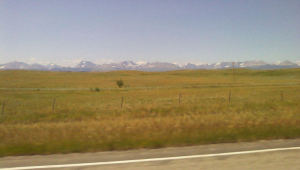
David and his grandparents are eating in a cafe in Browning Montana with the mountains of Glacier Park not far away – gohomekiki photo on Flickr
For reasons unknown to David—and he knew better than to poke into the matter—his grandparents finished their hamburgers before attacking the fries. Katoya stacked her fries up as though she planned to set fire to them; they looked like kindling arranged for a campfire. Then she dumped ketchup over the resulting pyramid and sloppily plucked them out two or three at a time. Jayee stacked his fries up like cordwood on the left side of his plate, saving the longest of them for constructing an enclosure on the right side of his plate for a man-made lake of ketchup. Under no circumstances was any of the ketchup allowed to sully the plate’s central work zone. Jayee lifted each fry in turn off the cordwood stack with his fork, cut it into equal lengths with his knife in the work zone, put the knife down across the far edge of the plate, transferred the fork to his right hand, carefully dipped the fry into the lake, and ate it without smearing any of the ketchup on his mouth. Nonetheless, he swiped a folded napkin across his face after finishing the last piece of each fry. He sipped his Coke after every three fries.
He ate with precision and order.
“I thought we might drive down to Heart Butte and see the tipi rings,” said Grandmother as
she licked the ketchup off her hands.
Jayee jumped like a spooked cat. His fork, which was hovering over the ketchup with a precision-cut section of a French fry, crashed into the lake. The damn burst and ketchup flooded across the work zone, engulfing the fries stacked on the far side of his world.
“Now look at this mess,” said Jayee. “I’ll need another plate. I’ll need another God damned
plate. Lucy, bring me another order, will you?
-
You can see the book’s Amazon listing here and it’s Barnes & Noble listing here.


May 15, 2013
Mortsafes: Protection FROM the Dead or FOR the Dead?
 I am happy to welcome Dianne K. Salerni (“We Hear the Dead,” “The Caged Graves”) with a somewhat spooky guest post about Mortsafes. I first met Dianne when we were both book reviewers for the same site. Since then, I’ve greatly enjoyed her books.
I am happy to welcome Dianne K. Salerni (“We Hear the Dead,” “The Caged Graves”) with a somewhat spooky guest post about Mortsafes. I first met Dianne when we were both book reviewers for the same site. Since then, I’ve greatly enjoyed her books.
Mortsafes
Given the current popularity of vampires and zombies, it’s no wonder that anyone stumbling across a mortsafe would automatically think of the undead. But these iron cages, found mostly in the U.K. and especially Scotland, were designed to protect the dead, not the living.

Mortsafe in Greyfriars Kirkyard, Edinburgh – Wikipedia Photo
In the early 19th century, fresh bodies were in great demand in medical schools, where students practiced dissection to learn anatomy. The lack of any legal way to acquire such bodies led inevitably to grave-robbing, which for a time became a rampant problem near places with medical schools, like Edinburgh. “Resurrection men” were forced to widen their net, transporting bodies across great distances, as people caught on and took steps to prevent their loved ones’ bodies.
Iron cages, ugly, practical, and effective, started appearing in Scotland around 1816. The general practice was to remove them after six weeks or so, although some survive in various cemeteries around the U.K., left in place and forgotten.

Asenath grave; Sarah grave in background in PA – Bob Salerni photo.
In the United States, to the best of my knowledge, there are only two mortsafes in existence – a pair of lovely, iron cages over two graves in Catawissa, Pennsylvania, a town nestled between the Susquehanna River and the Pocono Mountains. These mortsafes are quite different, and a bit of a mystery surrounds them.
First of all, they are decorative, which suggests they were meant to stand more than the usual six weeks – and in fact, they have done so. Secondly, they are the only mortsafes ever reported in this region, which is located nowhere near a medical school. Grave-robbing did occur in 19th century America. One particularly gruesome incident occurred less than five months before these mortsafes were built, but it happened 275 miles away in Cleveland, Ohio.
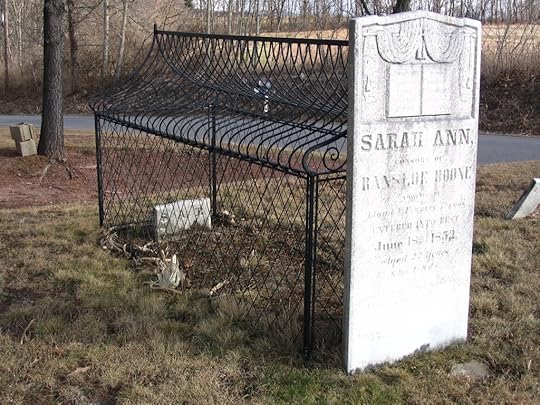
Sara Ann grave in PA. Bob Salerni photo.
The graves belong to two young women, Sarah Ann Boone and Asenath Thomas. They were sisters-in-law, and they died within a couple days of each other in June, 1852. The cause of death is not recorded, and I find it strange that – although they were both married – there are no graves for their husbands nearby. In fact, the whole cemetery is odd, in that all the headstones seem to belong to women and children. I examined every headstone left standing and found only one for a grown man.
It has been suggested that these two mortsafes were merely decorative, meant to display the affluence of a grieving family burying two young women in such a short span of time. However, decorative or not, they are definitely cages, and they are odd. In order to trim the grass, it would have been necessary to unlock the cage doors and crawl inside, which violated a contemporary taboo about walking over graves. This seems like a very bizarre way to memorialize beloved members of one’s family.
One has to wonder: Why cover the graves of these women – and only these two women? Who were they in life, and how did they die? I can only assume something very unusual happened in Catawissa, Pennsylvania during the summer of 1852. We may never know the truth, but I certainly did my best to create an entertaining story out of it.
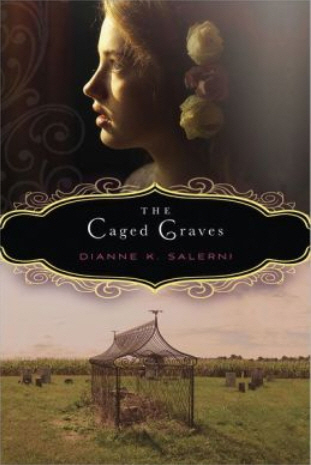 Dianne K. Salerni is an elementary school teacher in Pennsylvania and the author of two historical novels, WE HEAR THE DEAD (Sourcebooks 2010) and THE CAGED GRAVES (Clarion/HMH 2013), and a middle grade fantasy series, THE EIGHTH DAY (forthcoming from HarperCollins beginning 2014).
Dianne K. Salerni is an elementary school teacher in Pennsylvania and the author of two historical novels, WE HEAR THE DEAD (Sourcebooks 2010) and THE CAGED GRAVES (Clarion/HMH 2013), and a middle grade fantasy series, THE EIGHTH DAY (forthcoming from HarperCollins beginning 2014).
Follow Dianne on Facebook
Author’s website


May 13, 2013
Hello Pinterest Fans
 Ever cautious, I was the last to arrive on MySpace. “What is Facebook all about?” I used to wonder. I’m “on” Twitter, but there are days when I don’t know how to keep up with the tweets. True to form, I didn’t show up on Pinterest’s doorstep the day they opened for business.
Ever cautious, I was the last to arrive on MySpace. “What is Facebook all about?” I used to wonder. I’m “on” Twitter, but there are days when I don’t know how to keep up with the tweets. True to form, I didn’t show up on Pinterest’s doorstep the day they opened for business.
In fact, I stayed away until this past weekend. All my colleagues at Vanilla Heart Publishing were all already creating boards and pins (whatever that meant) and wondered why I wasn’t.
This weekend, I was too tired to do anything else after mowing the yard, so I looked at Pinterest. Hmm, not too bad. I set up boards called Joy of Travel, Books for Fantasy Lovers, This and That from My Blogs, and Resources for Writers. Things went smoothly. It was fun. Here’s the link.
-
Coming up Next: Author Dianne Marenco Salerni (“We Hear the Dead,” “The Caged Graves”) will be here in several days with a great guest post. With today’s zombie fad, we usually hear about protecting the living from the dead. However, there have been times when the dead needed to be protected from the living.
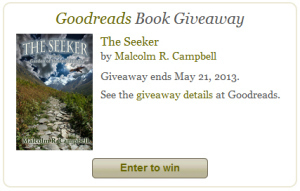 Stop by GoodReads for a chance at winning a free copy of my new novel about love, magic and fate. The giveaway ends May 21, 2013.
Stop by GoodReads for a chance at winning a free copy of my new novel about love, magic and fate. The giveaway ends May 21, 2013.


May 9, 2013
The seared images of ‘Body Heat’
 Ned: I need someone to take care of me, someone to rub my tired muscles, smooth out my sheets.
Ned: I need someone to take care of me, someone to rub my tired muscles, smooth out my sheets.
Matty: Get married.
Ned: I just need it for tonight.
–from “Body Heat” starring William Hurt as Ned and Kathleen Turner as Matty
From the sex to the crime to the moody saxophone music to Florida’s hot summer days when small-town lawyer Ned Racine meets the married, but overtly sexual Matty Walker, “Body Heat” was, in 1981, the kind of film everyone talked about. Men wanted to be Ned even though things ended up badly. Women wanted to be Matty because she got everything she wanted.
When I watch this film today on DVD, it still plays well. I do like noir films. I did grow up in Florida in the days before air conditioning when everyone sweated when the temperature outside reached 98.6 degrees or higher. And, John Barry’s music is the kind of music I remember hearing in blues bars on those summer nights when I was hoping to meet somebody like Matty Walker who didn’t want me to kill a husband for her. But it’s more than that, though what is is, is hard to define
Movies have become more permissive since 1981. Skimpy clothing, more innuendos, racier language than Ned Racine ever used, and more body heat than most people experienced in “real life.” Think of it: The near-nudity on “Survivor” is more extravagant, the language on “Hells Kitchen” is more profane, and the urgent sexual encounters on “Grey’s Anatomy” are more frequent than in most of the films we saw thirty-two years ago.
My wife and I saw “Body Heat” in a packed theater with another married couple. Afterwards, all of us commented about the same sexual encounter when the audience was stunned into an overt hush. When Ned throws a porch chair through the front door of Matty Walker’s house while she stands inside at the foot of the stairs waiting, leading to wildly hot sex in the foyer, nobody in the audience moved, chewed popcorn, breathed, looked at anyone else, or even risked allowing a tangible thought to enter their brains.
If you saw this film thirty-two years ago or even last week, that scene may well be hard-wired into your memory of movie moments. Watching the movie now, my experience of the film is partly based on how I reacted to it with five hundred other people that night. I can still feel that stunned hush.
As an author, I look closely at what produces a stunned hush in readers and movie goers. It need not be sex. It may be a car chase, a serene moment in a beautiful setting, or a conversation in a bar while a a bluesy enchantress sings out her troubles. What exactly makes for the perfect combination of setting, action, and words to thoroughly capture (and control) the heart and soul of a reader or a viewer?
Perhaps you remember a film or a novel with a scene that has stayed with you long after you first saw it or read it. Maybe the scene is tied together in your memory with the weather, the daily news, the people you were with, and the kind of day you were having when that fictional moment stopped you in your tracks. We know it when we see it and we know it when we read it…
Ned: Maybe you shouldn’t dress like that.
Matty: This is a blouse and a skirt. I don’t know what you’re talking about.
Ned: You shouldn’t wear that body.
Malcolm R. Campbell is the author of four novels, including the recently released “The Seeker,” a story with a high degree of body heat between the covers.







